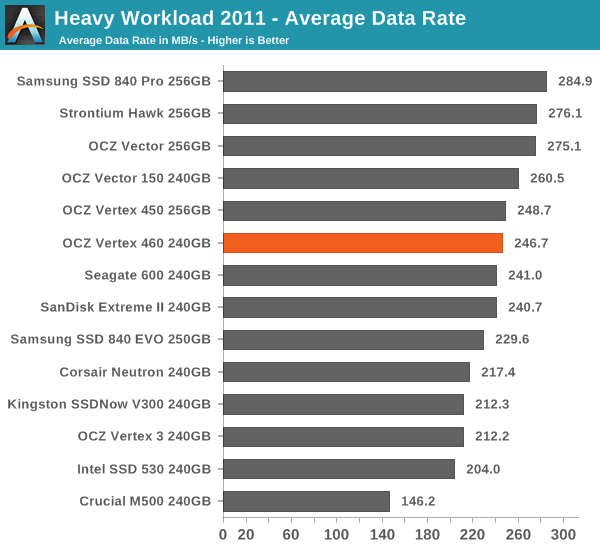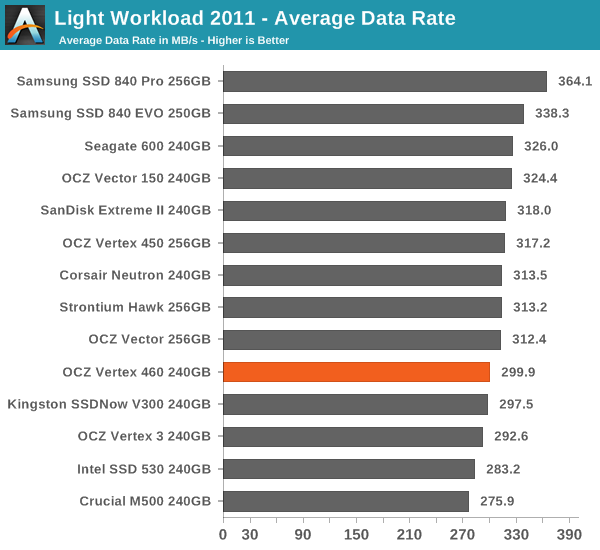OCZ Vertex 460 (240GB) Review
by Kristian Vättö on January 22, 2014 9:00 AM EST- Posted in
- Storage
- SSDs
- OCZ
- Indilinx
- Vertex 460
AnandTech Storage Bench 2011
Two years ago we introduced our AnandTech Storage Bench, a suite of benchmarks that took traces of real OS/application usage and played them back in a repeatable manner. Anand assembled the traces out of frustration with the majority of what we have today in terms of SSD benchmarks.
Although the AnandTech Storage Bench tests did a good job of characterizing SSD performance, they weren't stressful enough. All of the tests performed less than 10GB of reads/writes and typically involved only 4GB of writes specifically. That's not even enough exceed the spare area on most SSDs. Most canned SSD benchmarks don't even come close to writing a single gigabyte of data, but that doesn't mean that simply writing 4GB is acceptable.
Originally the benchmarks were kept short enough that they wouldn't be a burden to run (~30 minutes) but long enough that they were representative of what a power user might do with their system.
1) The MOASB, officially called AnandTech Storage Bench 2011 - Heavy Workload, mainly focuses on the times when your I/O activity is the highest. There is a lot of downloading and application installing that happens during the course of this test. Our thinking was that it's during application installs, file copies, downloading and multitasking with all of this that you can really notice performance differences between drives.
2) We tried to cover as many bases as possible with the software incorporated into this test. There's a lot of photo editing in Photoshop, HTML editing in Dreamweaver, web browsing, game playing/level loading (Starcraft II & WoW are both a part of the test) as well as general use stuff (application installing, virus scanning). We've included a large amount of email downloading, document creation and editing as well. To top it all off we even use Visual Studio 2008 to build Chromium during the test.
The test has 2,168,893 read operations and 1,783,447 write operations. The IO breakdown is as follows:
| AnandTech Storage Bench 2011 - Heavy Workload IO Breakdown | ||||
| IO Size | % of Total | |||
| 4KB | 28% | |||
| 16KB | 10% | |||
| 32KB | 10% | |||
| 64KB | 4% | |||
Only 42% of all operations are sequential, the rest range from pseudo to fully random (with most falling in the pseudo-random category). Average queue depth is 4.625 IOs, with 59% of operations taking place in an IO queue of 1.
AnandTech Storage Bench 2011 - Heavy Workload

The full results, including disk busy times and read/write separations, can be found in our Bench.
AnandTech Storage Bench 2011 - Light Workload
Our light workload actually has more write operations than read operations. The split is as follows: 372,630 reads and 459,709 writes. The relatively close read/write ratio does better mimic a typical light workload (although even lighter workloads would be far more read centric). There's lots of web browsing, photo editing (but with a greater focus on photo consumption), video playback as well as some application installs and gaming.
The I/O breakdown is similar to the heavy workload at small IOs, however you'll notice that there are far fewer large IO transfers. Interestingly, the 480GB drive actually comes out ahead in this case, suggesting it's more capable at light workloads.
| AnandTech Storage Bench 2011 - Light Workload IO Breakdown | ||||
| IO Size | % of Total | |||
| 4KB | 27% | |||
| 16KB | 8% | |||
| 32KB | 6% | |||
| 64KB | 5% | |||











69 Comments
View All Comments
Hrel - Wednesday, January 22, 2014 - link
Seems to me Mushkin is the SSD to get right now. Only one rated at 2Million MTBF that I've seen as well as having very high sequential and random IOPS.dcollins - Wednesday, January 22, 2014 - link
Sorry, I don't take chances with storage. Samsung SSDs can't be beaten right now, and have proven rock solid over the last year. My family has 5 in total and most of my teammates at work have 500GB drives. Zero problems, great performance. Going with OCZ just seems needlessly risky.blanarahul - Wednesday, January 22, 2014 - link
And that sums up the review. Samsung is like the Goku of SSDs. Try hard as you might. You can't beat them in long term.LB-ID - Wednesday, January 22, 2014 - link
They have new corporate overlords, but it's still the same OCZ. That's really all I needed to know. I simply cannot trust the people at OCZ for any of the things I care about in a product: reliability, accountability, and service.ezridah - Wednesday, January 22, 2014 - link
The Newegg prices are different for the 2 lower capacity drives today. They are now $120 for the 120GB and $140 for the 240GB. Not a bad price for the 240GB drive. An extra $20 for double the storage is a no-brainer.Bob Todd - Wednesday, January 22, 2014 - link
They've also got the 240GB Crucial M500 for $130 right now...BlakKW - Thursday, January 23, 2014 - link
"By doing additional validation, OCZ is able to pick the highest endurance parts and use them..."I don't understand this and it makes me curious: how can NAND be tested for endurance, and then used in an SSD? It seems to me that any extensive testing would use up a significant portion of the NAND's finite lifespan?
And if testing the identical parts, how does a test differentiate good vs bad when it comes to endurance?
TY
lmcd - Friday, January 24, 2014 - link
I'm sure the endurance testing doesn't come from simply wearing it out and testing. There may be some extrapolation methods or some different tools altogether.LordConrad - Thursday, January 23, 2014 - link
I have never had any issues with OCZ SSDs. I think this Vertex 460 looks like a decent drive, although I would go for the Vector due to the longer warranty.chris81 - Thursday, January 23, 2014 - link
Typo: 4KB Random Read is written twice in the first table. The second one should be Random Write